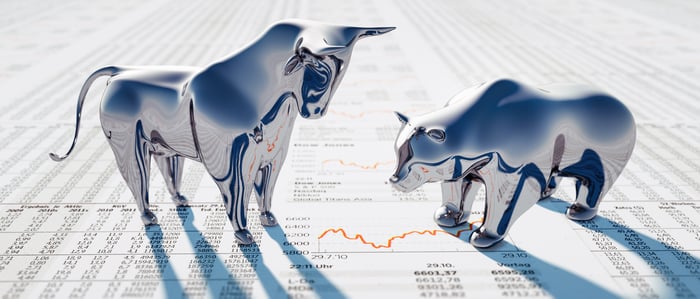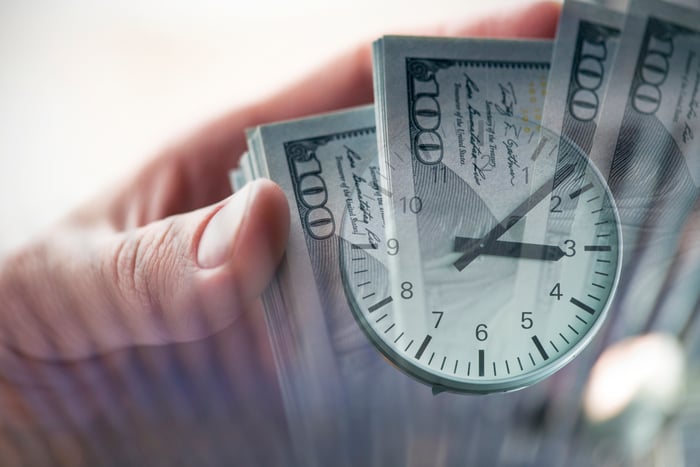For Wall Street and investors, 2020 will go down as a year that won't soon be forgotten. The coronavirus disease 2019 (COVID-19) pandemic completely unseated societal and business habits, led to a record-breaking spike higher in the U.S. unemployment rate, and sent the CBOE Volatility Index to all-time highs.
For some added context on this last point, previous bear market declines that reached at least 30% took, on average, 11 months to reach that mark. The coronavirus crash, by comparison, lopped 34% off of the benchmark S&P 500 (^GSPC -0.22%) in just 33 calendar days (less than five weeks), and sent the iconic Dow Jones Industrial Average (^DJI 0.06%) into bear market territory after just 16 trading sessions (a little over three weeks).
It was a crazy and unnerving time for investors. And now, 175 calendar days later, it's ancient history.

Image source: Getty Images.
The stock market is now 38-for-38 since 1950
Since 1950, stock market corrections have occurred with greater frequency than you might realize. According to data provided by Wall Street analytics company Yardeni Research, there have been 38 official stock market corrections in the S&P 500 over the past 70 years. By "official" correction, I'm referring to declines of at least 10% from a recent high, without rounding. This works out to a correction, on average, every 1.84 years.
One of the few things we know about stock market corrections is that, aside from being common, they're highly unpredictable. We'll never know when one is going to occur ahead of time, nor will we know how long a correction will last or how steep the decline could be. Often times, an X-factor comes out of left field and sends the stock market lower (e.g., COVID-19), rather than the one catalyst everyone seems to hone in on (the U.S.-China trade war).
This inability to see into the future or know how businesses, central banks, or consumers will react to external pressures is precisely why there aren't considered to be any "sure things" when it comes to investing. Then again, this statement isn't entirely accurate.
You see, there is one stock market guarantee that's been proven right time and again over the past seven decades. With the S&P 500 briefly eclipsing its February 19 closing high of 3,386 during the trading session on Wednesday, August 12, the stock market officially put the coronavirus correction into the rearview mirror.
In other words, the stock market is now a perfect 38-for-38 since 1950 in erasing all of its downside corrections. Eventually, optimists always come out ahead.

Image source: Getty Images.
The not-so-secret formula to long-term investing success
Once again, we can't predict how long it'll take for downside moves in indexes to be recouped. However, we know as virtual fact that, over time, indexes and many of their underlying components tend to increase in value as operating income grows. Thus, long-term investors who seize the opportunity to buy during periods of weakness, and who aren't chased out of their positions by what's often very short-term volatility, tend to be handsomely rewarded.
Thus, the first rule of navigating any stock market correction is to stay the course and trust in your investment thesis. Should your thesis change, selling is always an option. But in many instances I've found that short-term volatility rarely alters a company's growth strategy.
When stock market corrections strike, it's also never a bad idea of to consider buying dividend stocks. Companies that pay a dividend are almost always profitable, and they typically have time-tested business models that provide excellent growth transparency. The payouts you receive can help partially hedge against near-term downside, or they could be reinvested to compound wealth creation.
Best of all, dividend stocks have run circles around their non-dividend-paying peers over the long haul. Between 1972 and 2012, a Bank of America/Merrill Lynch report found that publicly traded companies initiating and growing their payouts produced an average annual return of 9.5%. This compared to a meager 1.6% average annual return for non-dividend stocks over this same 40-year stretch.

Image source: Getty Images.
Though this might sound contrary to "buy dividend stocks," don't overlook growth stocks, either. While there's no question that businesses with higher valuation premiums and/or ongoing losses could face wider volatility swings during a stock market correction or bear market, the share price upside for growth stocks over the long run can be huge.
During bear markets, in particular, the Federal Reserve usually lowers interest rates to spur lending. This has a positive impact on growth-oriented businesses by lower borrowing costs and encouraging expansion.
Furthermore, innovative companies with sustainable competitive advantages should naturally outperform over time, making them the perfect buy candidates during any sizable stock market correction.
About the only thing you don't want to do when the stock market plunges is buy stocks on margin. Although using margin is unavoidable in certain situations (e.g., short-selling a stock), the unpredictability of short-term equity movements makes using margin exceptionally risky, and can ultimately exacerbate your losses.
Long story short, the next time the stock market corrects, be a confident buyer of equities, because long-term investors are batting a perfect 1.000!




